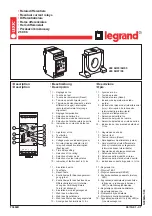
Instruction Leaflet
DT3000
Page 34
Effective: Date 07/02
I.B. 17555D
For more information visit:
www.cutler-hammer.eaton.com
Supersedes I.B. 17555C dated November 1999
5-5.1 BEFORE POWER APPLICATION
a) Verify that all wiring is correct, as shown on the wiring
plan drawing.
b) Set the DIP switches per Table 5.1 to configure the
Digitrip 3000.
5-5.2 INITIAL POWER APPLICATION
a) Apply control power to the Digitrip 3000 Protective
Relay.
b) Insure that the Operational LED on the front of the
relay is blinking green.
5-6 MISCELLANEOUS TESTING
DO NOT PERFORM DIELECTRIC TESTING
BETWEEN THE DIGITRIP’S METAL BACKPLATE
OR THE EARTH GROUND TERMINAL (TB1-4) AND
EITHER OF THE CONTROL VOLTAGE INPUT
TERMINALS (TB1-5,TB1- 6) AND AUXILIARY
“52B” INPUT TERMINALS (TB1-9, TBI -1 0). BOTH
OF THESE SETS OF TERMINALS HAVE SURGE
PROTECTION MOVS INSTALLED TO EARTH
GROUND AND COULD BE ADVERSELY
AFFECTED BY SUCH TESTING.
Dielectric Notes:
1. The current transformer input terminals labeled (A1,
A2), (B1, B2), (C1, C2) and (G1, G2) are 5 ampere
type current, transformer inputs. These inputs have a
3000 volt ac breakdown rating for 1 minute between
phases.
2. The relay output contacts COMMUNICATIONS
CLOSE, TRIP INST AND TRIP
OC/COMMUNICATIONS have a 2000 volt ac
breakdown rating for 1 minute between open contacts.
The relays trip alarm and protection off alarm have a
1000 volt ac breakdown rating.
3. All other terminals have a 1500 volt ac breakdown
voltage for 1 minute to earth ground except for the
above CAUTION restraint.
SECTION 6: MAINTENANCE AND STORAGE
6-1 GENERAL
The Digitrip 3000 Protective Relay is designed to be a self
contained and maintenance free unit. The printed circuit
boards are calibrated and conformally coated at the
factory. They are intended for service by factory trained
personnel only. The Troubleshooting Guide (Table 6.1) is
intended for service personnel to identify whether a
problem being observed is external or internal to the unit. If
a problem is identified to be internal, the unit should be
returned to the factory for repair or replacement as
described in the “Replacement” section below.
6-1.1 STORAGE
The Digitrip 3000 Protective Relay should be stored in an
environment that does not exceed the specified storage
temperature range of -40°C to +70°C. The environment
should also be free of excess humidity. There are no
aluminum electrolytic capacitors used in the relay,
therefore it is not a requirement to power the unit
occasionally. If possible, the relay should be stored in its
original packing material and container.
6-2 TROUBLESHOOTING GUIDE (TABLE 6.1)
ALL MAINTENANCE PROCEDURES MUST BE
PERFORMED ONLY BY QUALIFIED PERSONNEL
WHO ARE FAMILIAR WITH THE DIGITRIP 3000
PROTECTIVE RELAY, THE ASSOCIATED
BREAKER AND CURRENT LINES BEING
MONITORED. FAILURE TO OBSERVE THIS
WARNING COULD RESULT IN EQUIPMENT
DAMAGE, SERIOUS INJURY, AND/OR DEATH.
TROUBLESHOOTING PROCEDURES MAY
INVOLVE WORKING IN EQUIPMENT AREAS WITH
EXPOSED LIVE PARTS WHERE THE HAZARD OF
A FATAL ELECTRIC SHOCK IS PRESENT.
PERSONNEL MUST EXERCISE EXTREME
CAUTION TO AVOID INJURY OR EVEN DEATH.
ALWAYS DISCONNECT AND LOCK OUT THE
CURRENT SOURCE AND CONTROL POWER
SUPPLY BEFORE TOUCHING THE COMPONENTS
ON THE REAR OF THE DIGITRIP 3000
PROTECTIVE RELAY.
6-3 REPLACEMENT
Follow these procedural steps to replace the Digitrip 3000
Protective Relay.
Step 1:
Turn off control power at the main disconnect or
isolation switch of the control power supply. If the switch is
not located in view from the relay, lock it out to guard
against other personnel accidentally turning it on.
Step 2:
Verify that all “foreign” power sources wired to the
relay is de-energized. These may also be present on the
alarm terminal block. Current transformer inputs must be
temporarily shorted at a point prior to the relay’s terminals
before attempting to open these terminals on the Digitrip
3000.
Step 3:
Before disconnecting any wires from the unit,
make sure they are individually identified to ensure that
reconnection can be correctly performed.
Step 4:
Remove wires by loosening or removing the screw
terminal where there is a wire connection.
WARNING
















































